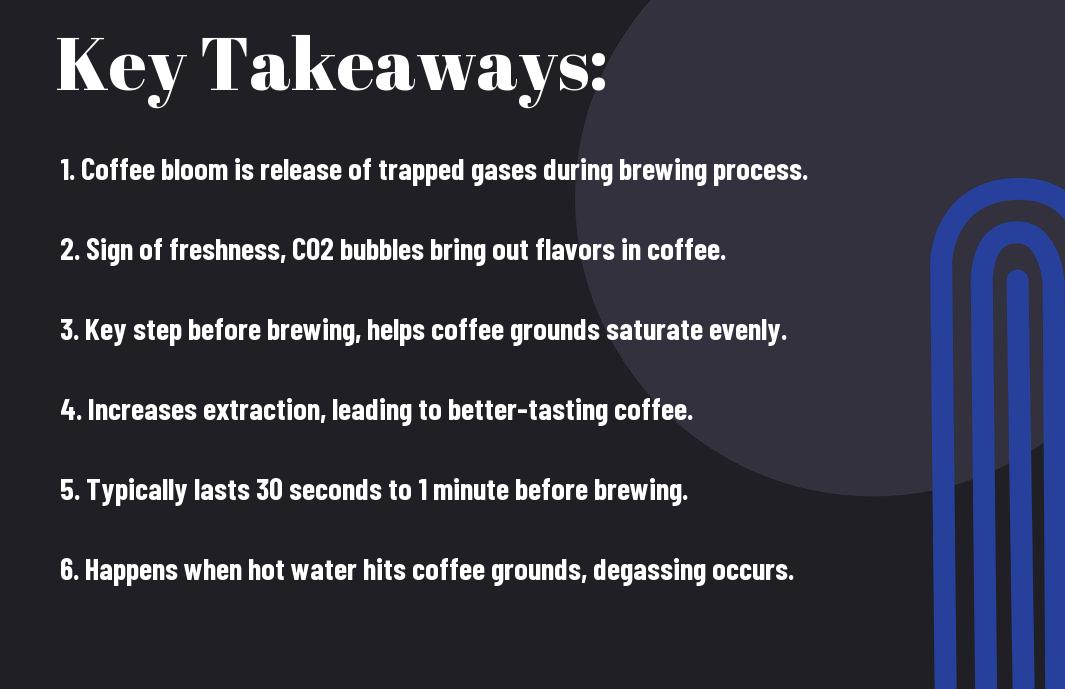Most coffee enthusiasts are familiar with the term “bloom” when it comes to brewing their favorite drink, but what exactly is a coffee bloom? In this informative post, we investigate into the science and art behind this crucial step in the coffee brewing process. Understanding the coffee bloom can elevate your coffee-making skills and enhance the flavors in your cup. Let’s explore the magic that happens when hot water meets freshly ground coffee beans.
Key Takeaways:
- Coffee Bloom: The coffee bloom is the initial phase of the brewing process where hot water interacts with freshly ground coffee.
- Carbon Dioxide Release: During the bloom, carbon dioxide is released from the coffee grounds, which causes the coffee bed to puff up or rise.
- Flavor Extraction: The bloom is crucial for flavor extraction as it allows the coffee grounds to degas and prepare for the optimal brewing process.
- Brewing Consistency: Achieving a proper coffee bloom ensures a more consistent and flavorful extraction, leading to a better cup of coffee.
- Home Brewing Tips: To enhance your coffee bloom at home, use fresh coffee beans, grind them just before brewing, and pour hot water evenly over the grounds to facilitate a uniform extraction.
Definition and Origins
What is a coffee bloom?
A coffee bloom is a fascinating phenomenon that occurs when hot water is poured over freshly ground coffee beans. This process leads to the release of carbon dioxide gas trapped within the beans, causing them to swell and rise to the surface of the coffee bed. The bloom is characterized by a foamy cap that forms on top of the coffee grounds, creating a visually appealing effect.
Historical roots of coffee blooming
With the rising trend of specialty coffee and a growing interest in the nuances of coffee brewing, the concept of coffee blooming has gained popularity in recent years. However, the practice of blooming coffee grounds has been around for centuries, with roots tracing back to traditional coffee-making methods in various parts of the world. In regions like Ethiopia and Yemen, where coffee cultivation originated, blooming has long been an vital step in the coffee brewing process.
The release of carbon dioxide during the blooming process helps prepare the coffee grounds for extraction by allowing water to saturate more evenly through the bed of coffee. This leads to a more uniform extraction and enhances the flavor profile of the final brew. By understanding the historical significance of blooming in coffee brewing, we can appreciate how this simple yet crucial step has contributed to the rich tapestry of coffee culture worldwide.


The Science Behind Coffee Blooming
You may have noticed that when you pour hot water over freshly ground coffee, bubbles form and the grounds swell. This phenomenon is known as the coffee bloom, and it is a crucial step in the coffee brewing process that releases the coffee’s flavors and aromas.
Chemical reactions during blooming
Blooming occurs when hot water hits the coffee grounds, releasing carbon dioxide trapped in the beans during the roasting process. This release of gas causes the grounds to puff up and creates a bubbly surface. Along with carbon dioxide, other volatile compounds like oils and acids are also released during blooming, contributing to the coffee’s flavor profile.
Role of carbon dioxide in blooming
During blooming, carbon dioxide plays a significant role in pushing out stale carbon dioxide to make way for the fresh water to extract the coffee’s flavors. The release of carbon dioxide also helps in degassing the coffee, allowing for a more even extraction and a better tasting cup of coffee.
Role of carbon dioxide in blooming
In addition to aiding in the extraction of flavors, carbon dioxide also helps to create the characteristic crema on espresso. This layer of emulsified oils sits on top of a well-brewed shot of espresso and is a sign of a good extraction.
How temperature affects blooming
| On coffee solubility | On gas release |
| Higher temperatures increase the solubility of coffee compounds, leading to a more flavorful extraction. | Hotter water temperatures can accelerate the release of carbon dioxide during blooming, resulting in a more vigorous bloom. |
How temperature affects blooming
The temperature of the water used during blooming can impact the rate at which flavors are extracted from the coffee grounds. Warmer water can lead to a faster extraction, while cooler water may result in a more delicate flavor profile.
The Benefits of Coffee Blooming
Improved flavor profile
All coffee lovers know that the flavor of their favorite brew is of utmost importance. The coffee bloom plays a crucial role in enhancing the flavor profile of your cup of joe. When hot water is poured over freshly ground coffee, the gases trapped in the beans are released, allowing for a more even extraction of flavors during the brewing process. This results in a more balanced and flavorful coffee that is a true delight to savor.
Enhanced aroma
One of the most enticing aspects of brewing coffee is the wonderful aroma that fills the air. The coffee bloom significantly enhances this experience by releasing a burst of aromatic compounds as the coffee grounds degas. This burst of aroma is a prelude to the rich and inviting scent that wafts from your freshly brewed cup of coffee, adding to the overall sensory pleasure of the coffee-drinking experience.
Furthermore, the enhanced aroma of bloomed coffee can elevate your morning routine, making it a more enjoyable and indulgent experience.
Increased caffeine extraction
Regarding that morning caffeine boost, the coffee bloom proves to be a valuable ally. The initial release of gases during blooming allows for better saturation of the coffee grounds, leading to increased caffeine extraction during the brewing process. This means that your cup of coffee will not only taste better but also provide you with that extra kick of energy to start your day off right.
Blooming your coffee before brewing ensures that you are making the most of your coffee grounds and extracting all the caffeine they have to offer, giving you a more potent and satisfying cup of coffee.

How to Bloom Coffee
After learning about what a coffee bloom is, you may be curious about how to achieve the perfect bloom when brewing your coffee. Here is a step-by-step guide to help you achieve the optimal bloom:
Step-by-step guide to blooming
| Step | Instructions |
| 1 | Start by grinding your coffee beans to a medium-coarse consistency. |
| 2 | Place the coffee grounds into the filter of your coffee maker or pour-over device. |
| 3 | Slowly pour hot water over the coffee grounds, ensuring that they are evenly saturated. |
| 4 | Allow the coffee grounds to bloom for about 30 seconds before continuing with the brewing process. |
Tips for optimal blooming
Stepbystep, here are some additional tips to ensure optimal blooming:
- Use freshly roasted coffee beans for the best bloom.
- Ensure your water temperature is between 195-205°F for ideal blooming.
This will help release the trapped carbon dioxide, resulting in a better extraction of flavors from the coffee grounds.
Common mistakes to avoid
Optimal blooming can be affected by common mistakes that coffee enthusiasts often make. It is imperative to be aware of these mistakes to improve your brewing technique:
For instance, using old, stale coffee beans can hinder the blooming process and result in a flat-tasting cup of coffee. Additionally, using water that is too hot or too cold can also impact the blooming process and the overall flavor of the coffee.
Coffee Bloom vs. Coffee Steeping
Key differences between blooming and steeping
Once again, it’s necessary to understand the distinctions between blooming and steeping when it comes to brewing coffee. While blooming refers to the initial process of wetting the coffee grounds to release gases before fully brewing, steeping involves letting the coffee grounds sit in water for an extended period to extract flavors.
When to use each method
Steeping is commonly used in methods like French press or cold brew, where the coffee grounds are fully immersed in water for a longer duration. Blooming, on the other hand, is crucial when brewing with methods like pour-over or Aeropress, where the coffee grounds benefit from the initial release of gases by wetting them before continuing with the brewing process.
With an understanding of when to use each method, you can enhance the flavor and overall experience of your brewed coffee. Experimenting with blooming and steeping techniques can help you tailor your coffee brewing to your preferences, whether you enjoy bright and acidic flavors or a smoother cup.
Comparing flavor profiles
| Blooming | Steeping |
| Enhances acidity | Produces a fuller body |
| Allows for a more complex flavor profile | Can result in a stronger, bolder flavor |
Differences in flavor profiles between blooming and steeping methods can significantly impact the taste of your brewed coffee. Understanding these variations can help you choose the right technique based on your flavor preferences and the type of coffee beans you’re using.
This informative breakdown sheds light on the key differences between blooming and steeping methods when brewing coffee. Each method offers unique advantages in enhancing the flavor profiles of your brew, so experiment with both to find your perfect cup of coffee.
Coffee Bloom in Coffee Culture
Many coffee enthusiasts believe that the coffee bloom is not just a chemical reaction but an integral part of coffee culture. It adds a theatrical element to the coffee-making process, creating an exciting visual and aromatic experience for both baristas and coffee drinkers. The bloom is often seen as a sign of freshness and quality in specialty coffee, where baristas take great care to preserve this crucial stage in the brewing process.
Blooming in coffee ceremonies
With its mesmerizing bubbling and foaming, the bloom has become a highlighted moment in traditional coffee ceremonies around the world. Whether it’s the Japanese art of pour-over brewing or the elaborate Ethiopian coffee ceremony, the bloom symbolizes the beginning of a revered ritual that honors the journey of coffee from bean to cup.
Its role in coffee competitions
Bloom plays a significant role in coffee competitions, where baristas showcase their skills in brewing the perfect cup. A well-executed bloom can set the stage for a remarkable sensory experience, highlighting the flavors and aromas of the coffee beans. Judges often look for a balanced and controlled bloom as a mark of precision and expertise in the competitive world of coffee brewing.
A well-executed bloom can enhance the overall flavor profile of the coffee, bringing out nuanced notes and highlighting the coffee’s unique characteristics. By mastering the bloom, baristas can elevate their craft and deliver exceptional coffee experiences to their customers.
How blooming affects coffee pairing
A proper bloom sets the stage for a successful coffee pairing experience, enhancing the compatibility of coffee with various food items. The release of carbon dioxide during blooming can help cleanse the palate and prepare it for the rich flavors of the coffee, making it an necessary step in creating harmonious coffee pairings.
By understanding how blooming affects the taste and aroma of coffee, enthusiasts and professionals alike can experiment with different brewing methods and coffee pairings to create delightful and satisfying combinations that elevate the coffee-drinking experience.
Summing up
Hence, the coffee bloom is a crucial step in the coffee brewing process that involves releasing trapped gases from freshly roasted coffee grounds, allowing the hot water to extract flavors efficiently. If you want to examine deeper into the topic and understand the science behind blooming, you can check out this informative thread on What does blooming actually do? : r/Coffee. Mastering the bloom can lead to a more flavorful and aromatic cup of coffee, making it a step worth paying attention to for coffee enthusiasts and baristas alike.
FAQ
Q: What is a coffee bloom?
A: A coffee bloom is the process of degassing freshly roasted coffee beans when hot water is poured over them, resulting in the release of carbon dioxide gas.
Q: Why is the coffee bloom important?
A: The coffee bloom is important because it indicates the freshness of the coffee beans and allows for better extraction of flavors during the brewing process.
Q: How does the coffee bloom occur?
A: When hot water is poured over freshly ground coffee beans, the trapped carbon dioxide gas is released, causing the coffee grounds to rise and expand, creating a bloom effect.
Q: How long does the coffee bloom last?
A: The coffee bloom typically lasts for about 30 seconds to a minute, depending on the freshness of the coffee beans and the grind size.
Q: Does all coffee bloom the same way?
A: No, the intensity of the coffee bloom can vary depending on the roast level, freshness of the beans, grind size, and brewing method used.
Q: How can you enhance the coffee bloom?
A: To enhance the coffee bloom, use freshly roasted beans, a coarser grind size, and allow the coffee to degas for a few days after roasting before brewing.
Q: Does the coffee bloom affect the taste of the coffee?
A: Yes, a strong and vibrant coffee bloom can indicate a fresher and more flavorful cup of coffee, as it allows for better extraction of the coffee’s aromatic compounds and flavors.





